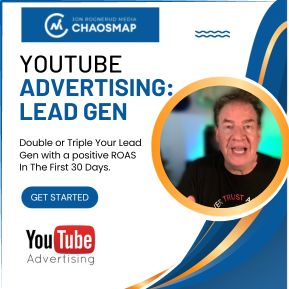Before you begin running ads on YouTube (Google Ads) – there are essential questions you must answer as part of building out a strategy. These questions (and answers) will help you and your executive team decide on the proper approach for building out your next YouTube advertising campaigns. These are important even if you have been running ads on other networks, or even Google search or shopping.
Further reading: Why YouTube Ads For Your Business?
Here are the top 10 questions to ask before launching any new ad campaigns on YouTube networks:
1. What are your primary goals for advertising on YouTube?
Are you looking to increase brand awareness, generate leads, or drive sales?
2. Who is your target audience?
Can you provide details about their demographics, interests, and online behaviors?
3. What type of video content are you planning to create for your YouTube ads?
Will you be producing educational, promotional, or testimonial videos?
4. Do you have a specific budget in mind for your YouTube advertising campaigns?
How much are you willing to spend daily or monthly to achieve your goals? Make sure to outline your CPA/CPS goals (or CPL goals for lead generation).
5. What is your preferred ad format?
Are you more interested in using skippable or non-skippable video ads, discovery ads, or bumper ads? If you don’t know – study your competition and see what they are using as a starter.
6. Are you planning to use any advanced targeting options, such as custom affinity or custom intent audiences, to reach a more specific audience?
Do you have research data (ex: Google Analytics) to back this up, and support the choices you are about to make?
7. How do you plan to measure the success of your YouTube advertising campaigns?
Which key performance indicators (KPIs) will you be monitoring to track your progress and optimize your campaigns? What additional metrics are the most important to the CEO, VP of marketing, CFO? Create a profitability matrix map and feed numbers into your worksheet before you launch. Run simulations in your funnel.
8. Have you considered creating dedicated landing pages for your YouTube ads to improve the user experience and increase conversions?
These pages should be congruent to the ad, and not the same as your Facebook or other platforms you are using. YouTube will be different.
9. Are you familiar with YouTube ad policies and guidelines to ensure your ads comply with the platform’s requirements?
Read up on the policies and to make sure you are not out of compliance. That includes country targeting as well.
10. Do you have any experience with other online advertising platforms, such as Google Ads or Facebook Ads?
Would you like to integrate your YouTube advertising efforts with these other platforms for a more comprehensive digital marketing strategy? If you are, make sure to segment messaging separately, and start simple. Don’t expect miracles or magic overnight. YouTube / Google Ads will take longer, and you need patience as you continue to test and track.
Once these questions have been answered and agreed upon, consider these important steps to implement your strategies for YouTube ads.
STEPS TO BUILD YOUTUBE ADS:
A. Define your target audience: Clearly identify your ideal customer profile, including demographics, interests, and pain points. This will help you tailor your ad content and targeting settings to effectively reach the right audience.
B. Create engaging video content: Develop compelling and informative video ads that showcase your expertise, offer solutions to common problems, and establish trust with potential clients. Ensure your videos are professionally produced with clear visuals and audio to leave a lasting impression.
C. Optimize ad formats and placements: Utilize the most suitable YouTube ad formats for your goals (e.g., skippable video ads, discovery ads, or bumper ads). Select placements that align with your target audience’s viewing habits, such as YouTube search results, YouTube videos, or video partners on the Display Network.
D. Implement advanced targeting: Leverage advanced targeting options, such as demographics, interests, keywords, and remarketing lists, to reach potential clients who are most likely to be interested in your services. Consider layering targeting options to refine your audience further.
E. Use strong calls-to-action (CTAs): Encourage viewers to take the next step in your marketing funnel with clear and compelling CTAs. Whether it’s scheduling a consultation, downloading a resource, or signing up for a webinar, make it easy for viewers to engage with your business.
F. Optimize landing pages: Design dedicated landing pages for each campaign to provide a seamless user experience and enhance lead generation. Ensure your landing pages are mobile-responsive, feature clear messaging, and include easy-to-complete lead capture forms.
G. Track and analyze performance: Regularly monitor key performance indicators (KPIs), such as views, watch time, click-through rate (CTR), and conversions, to gauge the effectiveness of your campaigns. Use data-driven insights to make informed adjustments to your targeting, ad creatives, or bids to optimize performance and maximize return on investment (ROI).
This article and steps, when followed, will provide a solid start for any new YouTube ads campaign(s).
If you need help or further guidance: Reach out and get a quote: right here. Fill out the form, get your strategy session booked (the call is free, and not a sales pitch). We genuinely try to help you first.
Jon Rognerud and Chaosmap work with Fortune 500 companies, associations and entrepreneurs to create digital traffic strategies that scale up members, customers, leads and sales with profitable returns. Mr. Rognerud wrote a best-selling book (Buy On Amazon), “The Ultimate Guide To Optimizing Your Website” (Entrepreneur). Connect directly here.







